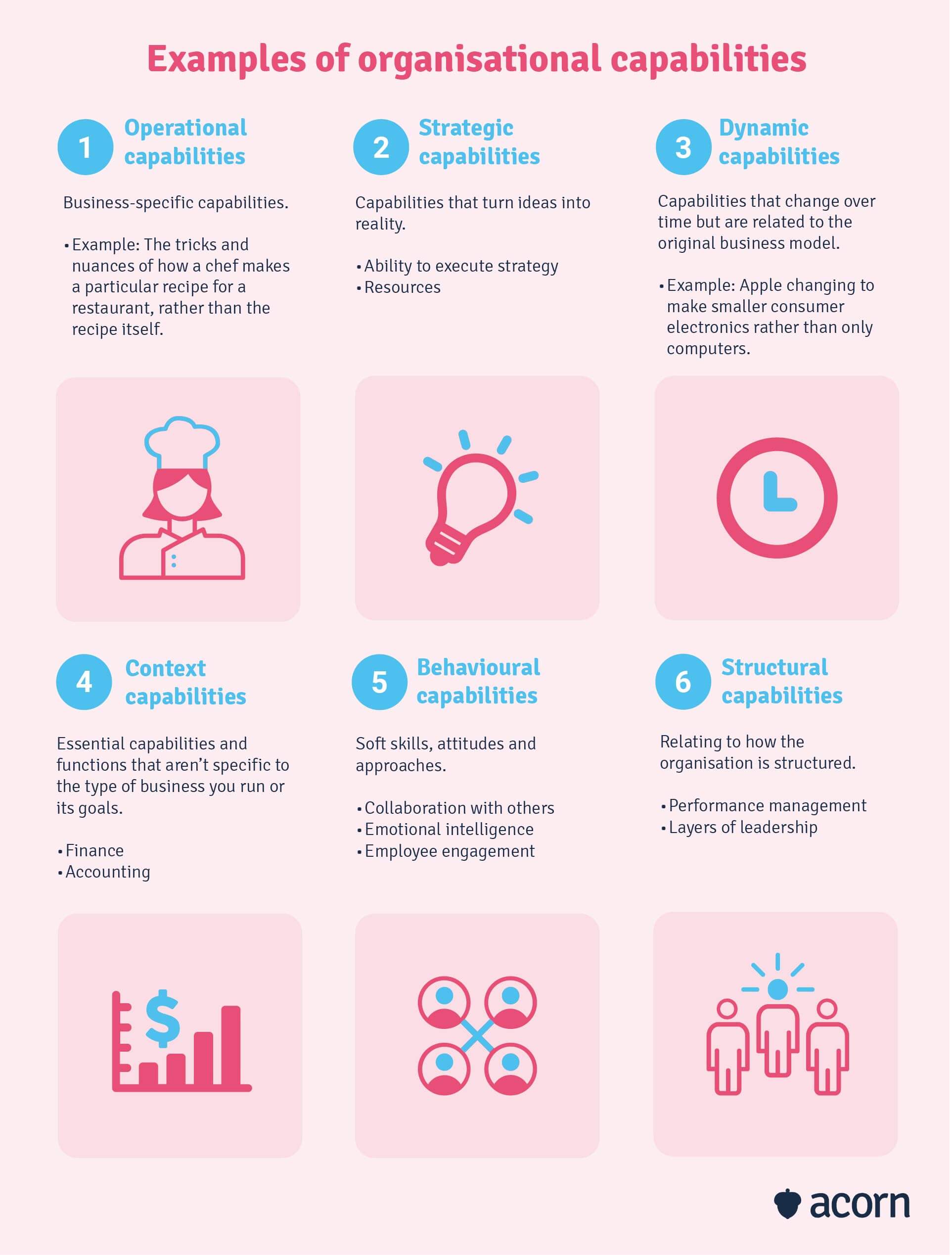How to Run an Organisational Capability Assessment for Your Business
Reading Time:

Lead the pack with the latest in strategic L&D every month— straight to your inbox.
SubscribeOrganisational capability assessments can measure the proficiencies of capabilities within your business.
Helpful, since organisational capability is key to developing competent employees, clear leadership brand and customer connectivity with your company. Organisational capabilities differ from individual capabilities in that they concern the performance and strategy of the business as a whole, rather than the actions and skills of the individual.
But you need to assess your organisational capability to ensure you’re on the right track to doing this. So, how do you perform a capabilities assessment for your business? We’ll break down the three steps to running a capabilities assessment.
What is organisational capability?
Organisational capabilities are the means by which a business brings its resources and people together to deliver value to stakeholders and customers and well as answer to industry and organisational changes. These are the strategic assets of an organisation–like expertise, systems and information–that are drawn on to execute business strategy and get work done.
The importance of organisational capabilities
Organisations stand out when they’re considered “coherent”. At a technical level, this means they have clear, defined capabilities aligned (i.e. coherent) with their external market position.
In other words: Organisational capabilities build value and drive strategy in a way that enables respect from customers who, when done consistently, will see your brand as trustworthy, reliable and relevant, because that’s what your business is good at.
Building the right strategic capabilities for your organisation drives your company’s effectiveness in:
- Adapting to change. When you’re on top of your organisational capabilities and how they align with your business strategy, you can plan for the future. This means planning for future roles, future skills, and future strategic goals.
- Performance management. Organisational capabilities inform the skills, behaviours and knowledge needed in job roles. This better informs performance management, improving it for everyone. This is why we’ve created a performance learning management system (PLMS) here at Acorn to codify and operationalise capabilities for improved organisational efficiency.
- Gaining a competitive advantage. Your organisational capabilities enable you to stay on top of customer demands and bring them value. Building organisational capabilities turns your organisational concerns into actions, creating strategic drivers.
The impacts of not assessing organisational capability
You need to assess and build organisational capability to ensure continuous improvement in your organisation’s practices and performance so you can maintain a competitive advantage and remain relevant in your industry. Your capabilities assessment highlights the areas that need to be improved upon to meet your strategic objectives. Not only that, but assessments help identify whether your organisation is on the right track towards meeting its goals.
If you don’t perform a capabilities assessment, this information will be lost to you. Perhaps your organisation is lacking in leadership skills, and, by extension, the potential future leaders who can help deliver your business strategy going forward. In fact, 71% of managers and leaders aren’t aligned with their organisation’s strategy. Not only will you not know you need leadership development, but the lack of necessary leadership skill now will hinder the future success of your organisation. A lack of sufficiently-developed capabilities leads to a lack of common understanding between your company and its customers.
How to perform an organisational capability assessment
An organisational capability assessment is a diagnostic tool designed to measure the organisation’s performance in its specific organisational capabilities. The idea is to rate the performance of the business and its capabilities against the industry as a whole.
So, let’s jump into the three steps to organisational capability assessments.
Step 1: Identify key capabilities
The first step in performing an organisational capability assessment is to define the crucial capabilities for your organisation. These are the building blocks of a capability framework.
The best way to do this is to first find your strategic intent or goal, as defined by the CEO’s mission priorities. This way, every decision you make from this point forward is informed by (and built on) this goal and everything is aligned from the start.
An organisation should start defining the right capabilities by determining what they’re best at doing. This can be overwhelming, because there are hundreds of organisational capabilities to choose from. At most, your company should stick to a maximum of six capabilities to develop. These are your core capabilities that define your company’s strengths.
- Operational capabilities are an organisation’s ability to align its skills and processes with its business strategy, enabling it to meet stakeholder expectations. Because these are specific to your organisation and its operations, sometimes they can be hard to spot. Your organisation may offer the same services as many others, but your operational capabilities are specific to how your business follows its processes.
- Strategic capabilities determine a company’s ability to execute their business strategy and vision. They transform ideas into reality.
- Dynamic capabilities are about adapting to change. These are capabilities that build and change over time in reaction to shifts in the business environment.
- Context capabilities are the behind-the-scenes functional capabilities that are essential but not unique to your specific business needs.
- Behavioural capabilities are related to the attitudes of employees towards their growth, while structural capabilities are connected to the structure and arrangement of the organisation.

Next, you need to determine your resources and processes.
- Resources include data sources, knowledge, financial resources and systems that support organisational capabilities.
- Processes are the means by which organisations turn resources into outputs. It’s about how people work together to meet objectives.
These are needed to build organisational capabilities for your company, which is why it’s important to define your goals beforehand. This way, you know how to prioritise resources and processes for each capability.
Step 2: Assess capabilities
Start with capabilities your organisation can and should be able to do in order to deliver on company strategy. Ask yourself what resources and processes are required for each of these capabilities so you can determine what your organisation needs in order to do it. You can use surveys, interviews or data to find this out.
There are two important pieces of information you should find from this step:
- The process and resourcing requirements for each of your capabilities
- An understanding of your organisation’s current capabilities (e.g. Where the company stands currently compared to your desired strategic goals).
An easy way to show this is with a matrix that displays capabilities in terms of maturity. It shows whether the maturity of your organisation’s capabilities are amateur or strategic. The five levels of capability maturity are:
- Initial
- Repeatable
- Defined
- Capable
- Efficient.
You can also use a capabilities assessment tool to perform a tailored organisational capability assessment for your business. It contains a catalogue of industry-specific capabilities that you can customise to match the needs and strategy of your company.
It can measure the maturity of your capabilities in action, by looking at importance vs proficiency. That is, how important certain capabilities are to your company’s success compared to how proficient your company actually is at performing them. The tool can even compare your organisational capability proficiencies against the proficiencies of “best-in-class” players in your industry as an indicator of your organisational success on the stage.
Step 3: Identify areas for improvement
When you develop organisational capability, you improve your business practices and performance. Your assessment is simply your method to gaining a clear understanding of the areas (such as the knowledge, expertise and collective skills) that need development.
It’s important to remember that an organisational capability assessment doesn’t solve capability gaps—only highlights them. You can use the information gained from your assessment to define an action plan, such as potential training opportunities for closing capability gaps and build focus for capability development programs.
Key takeaways
An organisational capability assessment is a valuable tool for understanding what your organisation is currently capable of doing, what they should be able to do, and the gaps between the two. It should gather enough information for you to utilise when it comes to planning for the future of your organisation and its strategic direction.